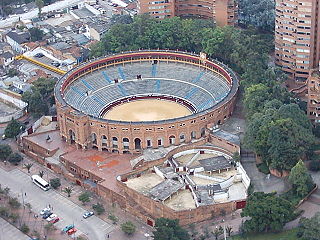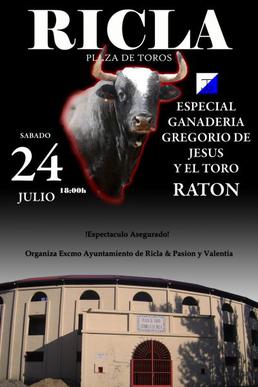
The Plaza de Toros de Las Ventas, known simply as Las Ventas, is the largest bullfighting ring in Spain, located in the Guindalera quarter of the Salamanca district of Madrid. It was inaugurated on June 17, 1931. Its seating capacity of 23,798, makes it the third-largest bullfighting run in the world, after bullrings in Mexico and Venezuela. After the federal ban of bulfighting in Plaza México, Las Ventas is the second largest bullring in the world still in operation for its original intention.

A bullring is an arena where bullfighting is performed. Bullrings are often associated with the Iberian Peninsula, but they can also be found through Iberian America and in a few Spanish and Portuguese ex-colonies in Africa. Bullrings are often historic and culturally significant centres that bear many structural similarities to the Roman amphitheatre.

The Plaza de Toros de Ronda is a Bullring in Ronda, it has a diameter of 66 metres (217 ft), surrounded by a passage formed by two rings of stone. There are two layers of seating, each with five raised rows and 136 pillars that make up 68 arches. The Royal Box has a sloping roof covered in Arabic tiles. The design of the main entrance to the bull ring features two Tuscan columns and the royal shield of Spain surround by baroque edging. The main door is large enough to allow horses and carriages to enter the ring, and above the door is an iron wrought balcony that embodies the bullfighting culture.

The plaza de toros de la Real Maestranza de Caballería de Sevilla is a 12,000-capacity bullring in Seville, Spain. During the annual Seville Fair in Seville, it is the site of one of the most well-known bullfighting festivals in the world. It is a part of the Real Maestranza de Caballería de Sevilla, a noble guild established for traditional cavalry training.

The Real Plaza de Toros de El Puerto de Santa María is a bullring in El Puerto de Santa María, Spain.

Santamaría Bullring is a bullring in Bogotá, Colombia, and it is currently used for bullfighting, although it has also been used for concerts and other cultural activities. The stadium holds 14,500 people and was built in 1931. This bullring is more commonly known as the Plaza de Toros Santamaría. Outside this bullring there is a statue honoring Pepe Cáceres, the famous Colombian torero. In 2012 the mayor of Bogotá, Gustavo Petro, announced entering into dialogue with the capital's community to ban bullfighting in the city and give the Santamaría Bullring another use, in addition to denying resources of public enterprises for such parties. In 2017, after 4 years of suspension, bullfighting returned to Santamaría Bullring because of Enrique Peñalosa's decision, the city's former mayor.

The Plaza de toros Nuevo Progreso is a bullring in the Mexican city of Guadalajara, Jalisco. It is currently used for bull fighting and also for hosting musical events, and professional wrestling events. The bullring holds 16,561 people and was built in 1966 to 1967.
Plaza de Toros Monumental de Valencia is a bull ring in Valencia, Venezuela. It is used for bull fighting and other events like concerts and fairs. It is the second largest bullring in the world, the first being the Plaza de toros México. The stadium holds 24,708 people and was built in 1968.
Neo-Mudéjar is a type of Moorish Revival architecture practised in the Iberian Peninsula and to a far lesser extent in Ibero-America. This architectural movement emerged as a revival of Mudéjar style. It was an architectural trend of the late 19th and early 20th centuries that began in Madrid and Barcelona and quickly spread to other regions in Spain and Portugal. It used Mudéjar style elements such as the horseshoe arch, arabesque tiling, and abstract shaped brick ornamentations for the façades of modern buildings.
Plaza de toros de Salamanca – La Glorieta, nicknamed La Glorieta or Plaza de Toros de La Glorieta, is a bullring at Avenida San Agustín, 1, Salamanca, Castile and León, Spain. It is currently used for bull fighting. The stadium holds 10,858 people. It was built in 1892 and officially opened on September 11, 1893. It is classical in style and has three levels made of stone, wrought-iron and brick. The ring is 54 metres (177 ft) in diameter.

Plaza de Toros de Valencia, officially Plaça de bous de València, is a bullring in València, Spain. It was built between 1850 and 1859 in the neoclassical style, inspired by civil Roman architecture such as the Colosseum in Rome or the Arena of Nîmes (France). It was built by the Valencian architect Sebastián Monleón Estellés. Its structure is formed by a 48-sided polygon, with 384 external arches. It follows the so-called Neo-Mudéjar style.

Afternoon of the Bulls is a 1956 Spanish drama film directed by Ladislao Vajda. It was entered into the 1956 Cannes Film Festival. The film was selected as the Spanish entry for the Best Foreign Language Film at the 29th Academy Awards, but was not accepted as a nominee.

Ratón was a Spanish fighting bull that was nicknamed el toro asesino, el sangriento toro Raton and el terrible Ratón for killing three people in bullfighting rings in Spain during 2006–2011 and injuring thirty more. The bull became legendary in Spain due to the large number of gorings for which he was responsible. Bullfighting fans regarded him as a star and traveled from across the country to see the morlaco at his home at Sueca near Valencia. Matador Jesús Esteve said of Ratón: "He is a killer. He is lazy, he doesn't want to participate. He does his own thing, waiting for somebody to make a mistake. And then when he gets you, he wallops you, and he doesn't let up."
Bullfighting was banned in the Spanish autonomous community of Catalonia by a vote of the Catalan Parliament in July 2010. The ban came into effect on 1 January 2012. The last bullfight in the region took place on 25 September 2011 at La Monumental. The ban was officially annulled for being unconstitutional by Spain's highest court on 5 October 2016. However, despite the overturning of the ban, no further bullfight had taken place in Catalonia as of July 2020.

The Plaza de Toros Monumental de Barcelona, often known simply as La Monumental, is a bullring in the city of Barcelona, Catalonia, Spain. It was the last bullfighting arena in commercial operation in Catalonia. It was inaugurated in 1914 under the name Plaza de El Sport and was soon expanded and given its current name in 1916. It is situated at the confluence of the Gran Via and Carrer Marina in the Eixample district. It has a capacity of 19,582 within 26 rows of lines, boxes, and stands on the first floor inside and an upper gallery surrounding the building.

The Plaza de Toros de El Bibio is a bullring located in Gijón, Asturias, Spain.

The Royal Fair of Algeciras is the most important annual festival in the Spanish city of Algeciras, held in June each year. Since it was established in 1850 as a cattle market, the fair and the fairground in which it is held have become popular attractions for the people of Algeciras and the surrounding towns of the Campo de Gibraltar. It has moved several times since its establishment and is now held in the Las Colinas area, where Algeciras's Las Palomas bullring is also located.

The Plaza de Toros de Albacete is a bullring in the town of the Albacete, in the region of Castilla-La Mancha (Spain).

La Malagueta is a bullring at Málaga, Andalucía, Spain. It is located in the eastern district of Málaga, in its namesake neighbourhood of La Malagueta.

The Plaza de Toros de Pontevedra (Spain) is the bullring of the Spanish city of Pontevedra and the only one in the autonomous community of Galicia. It has a capacity of 7,800 spectators and is classified as the second category of Spanish bullring. The current bullring replaced a wooden one dating from 1892, although the tradition of bullfighting in Pontevedra dates back to the 17th century.



















